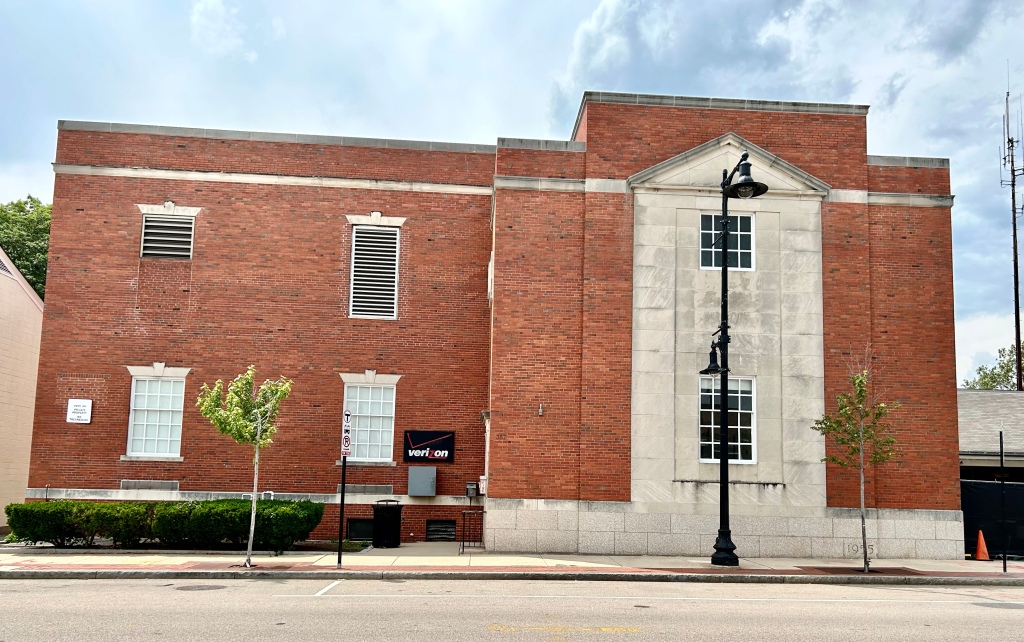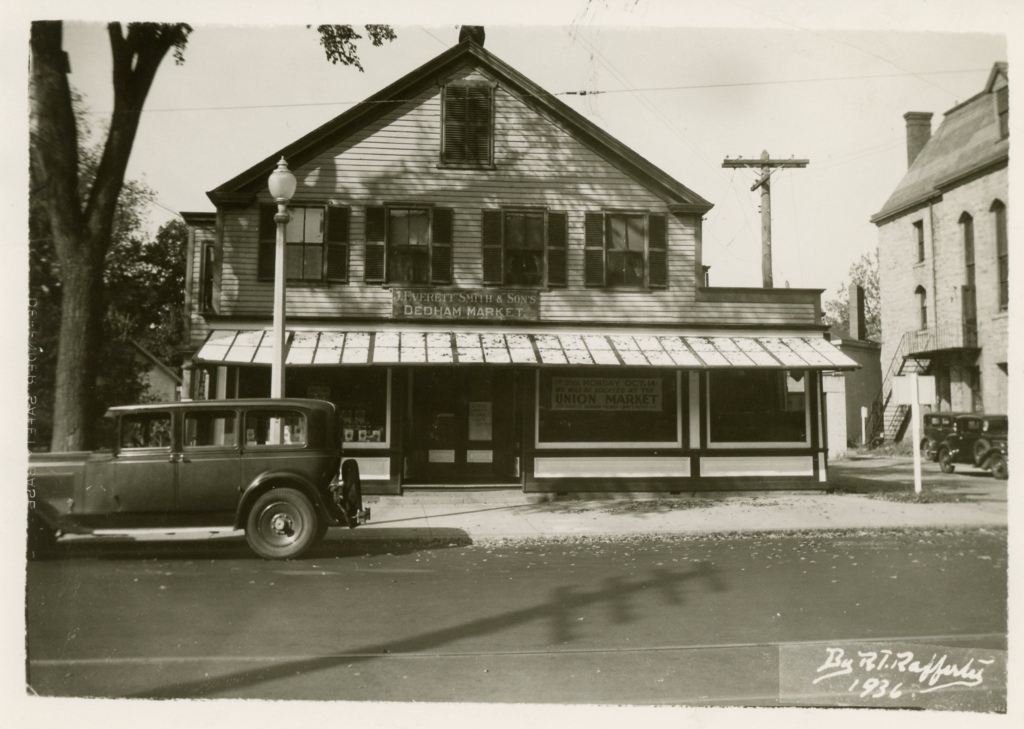New England Telephone and Telegraph Building (Verizon)
Brian Keaney correctly identified the Verizon building on Washington Street. I remember in 6th or 7th grade scrounging thin multi/colored wire from their trash so I could give it to the girls in my class to make rings out of. I bet most of us have never been inside this building. Here’s a little history:


Memorial Hall (future site of the new Town Green) is to the right
Image courtesy of the Dedham Museum and Archive
In July of 1954 the 88-year-old wooden J. Everett Smith Market building on Washington Street next to Memorial Hall was knocked down to make way for the New England Telephone and Telegraph Company’s new telephone exchange building. Construction began on the buildig in late 1955 and the cornerstone was laid on April 4, 1956. Inside the cornerstone a metal receptacle was placed which held “records and memoranda which describe fully and graphically the town of Dedham as it exists today” (Dedham Transcript)The gathered crowd included selectmen, telephone company officials, the town’s postmaster, police chief Walter Carroll, State Representative Francis Harding, Father William Kennedy of St. Mary’s Parish who delivered an invocation, and Reverend Leland Maxfield of the Westwood Baptist Church who delivered a benediction.

The construction of this building brought about a significant change for Dedham residents: the introduction of direct dialing. For years residents could only make operator assisted calls; the Dedham telephone exchange was DEdham 3. Calls were forwarded by operators at the telephone building on Church St. next to the library. Beginning at 2:01 AM on Sunday, December 1, 1957, customers could dial directly and had their numbers switched over to the new Dedham exchange of either DAvis 6 or DAvis 9. Ads began appearing in the Transcript in the fall informing customers of the change and instructing them how to use dial servce. The Avery School PTO even had a workshop for telephone users complete with an instructional film.

Workers had been busy since the beginning of the year, installing wires and cables, and attaching dial inserts to the older phones of customers. Residents also had the opportunity at this time to obtain a new phone in a variety of colors other than the usual black. The changeover to the new service caused the layoff of 176 operators who worked out of the Church St. building.
To commemorate this historic achievement, a long-distance call was made to Dedham, England. The call was placed by Dedham Historical Society president-emeritus Dr. Arthur Worthington from the society’s headquarters on High Street and included members of the society, telephone company executives, and Dedham Country Day 6th grader Sally Reed who got to speak with her English pen-pal. Also on-hand were Selectman Arthur Lee and Miss Margaret Dooley, who had been the chief operator at the Church St. facility for 39 years.

Telephone exchange names were phased out in the 1960s, but live on in popular culture, as in the Glen Miller song Pennsylvania 6-5000 and the book and movie Butterfield-8.
While there are still some customers with land lines who are connected through the building, today it is mainly a switching center for FIOS internet/telephone/television users.
Explore posts in the same categories: ...all the old familiar places
June 25, 2023 at 7:04 am
Excellent! Thx
LikeLike
June 25, 2023 at 8:51 am
I never knew that 326 was “Davis 6”! Thank you!
LikeLike
June 25, 2023 at 10:10 am
Hard to imagine there were 176 operators just for Dedham. But of course that had to include all the shifts to cover 24 hours and 7 days a week. And it presumably included Westwood, since many or all Westwood numbers are also 329. Can’t imagine where the operators could park. There is hardly enough parking just for the library, in that area, even now. They must have mostly lived in the area and walked, or perhaps have taken buses.
LikeLike
June 25, 2023 at 11:23 am
This is such interesting history! I’d never thought about when direct dialing came to be and the changes it brought.
LikeLike
June 25, 2023 at 11:25 am
I guess it’s the history of mid-century America. Glad you found it interesting!
LikeLike